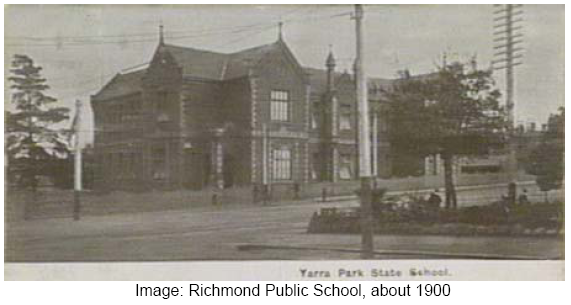Going to School in Richmond, 1900
Richmond is an inner city suburb in Melbourne, Australia. At the turn of the 20th century it was home to the poorest of the industrial working class. Historian Janet McCalman describes the local school. Here is a description of schooling in an inner city suburb of Melbourne, Australia, at the beginning of the 20th century. Most of these students would be destined to work in factories (if they were boys) or domestic service (if they were girls).

[Inside] these packed and decaying classrooms the children of Richmond were prepared for working-class life. They were given levels of literacy and numeracy fit only for the factory; they were instructed in hygiene to preserve the public health; girls acquired the domestic arts so that they could feed and clothe a factory on an inadequate income; boys where trained in wood- and metal-work to get their hand and eye in early; they played team sports to build character and sinew and relieve frustration; their art classes sought only to train them in accurate copying; their history rarely aspired beyond dates and propaganda about social classes and events that had nothing to do with common people like themselves; their geography was of climes and cities they would never see unless transported to far-flung battle lines; their nature study thrilled to the germination of a wheat seed on wet cotton wool and the life cycle of the Emperor Moth but never hinted at more complex modes of reproduction; above all, they were taught to learn by memory and belief and not question by investigation.
In his evidence before the Fink Royal Commission on Technical Education of 1900, the principal of Yarra Park school, Frederick Hayden, painted a portrait of an Edwardian Richmond school. He described a teaching staff crushed by the futility of its task and demoralized by an irrelevant syllabus, and the iniquities of Payment by Results. He pleaded for more teachers—a ratio of one teacher and one assistant per one hundred pupils being essential for effective teaching.
… [H]is description of Yarra Park’s … drawing classes eloquently testifies to the oppression of the spirit in the schools for the working class:
The present standard of drawing seemed fair enough to the average classes, but it might be improved by not having the younger children in the second and third classes confined so much to the drawing of lines and curves. They ought to be, as soon as possible, taught to draw something from nature, if it were only a leaf or some object in the room, or sticks placed in different positions. There was too much of the mechanical idea of giving out books to a large class, and flat copies to draw from and the children did not take much interest in this class of work.
McCalman, Janet. 1984. Struggletown: Public and Private Life in Richmond, 1900–1965. Melbourne: Melbourne University Press. pp.73–74. || WorldCat
